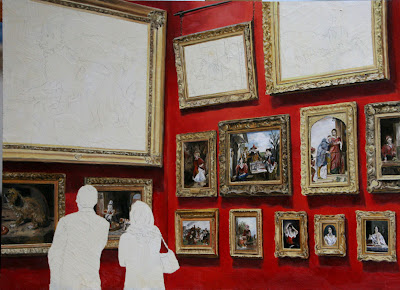Saturday, July 30, 2011
The Summit
This was a challenging painting. There were a number of times when I knew I was crazy to attempt it. It would have been easier to simplify the gold frames or take out a few pieces or just make the paintings less detailed. I didn't because I wanted to see if I could paint these walls.
The final painting in the upper left is Lion: A Newfoundland Dog by Sir Edwin Henry Landseer. Painted earlier than his two in the bottom left, it was completed in 1824.
This piece I saved for last thinking it is just a dog and would be easier than painting people. Why I saved it for last when it is the most important painting due to its focus and size and could doom my whole painting is beyond me. A risky move, but maybe the additional pressure really pushed me. I can't compare myself to Landseer but I hope I gave a semblance of his work so it reads like a Landseer.
The two art admirers were easier to paint yet are an essential part of what I am trying to say with the piece. I hope they provide the invitation to join them in appreciating the Masters.
For me, I am reminded of the debt each artist owes to those who created before him.
Is this my mountain top? Well, the subject matter was by far my most difficult.
One of the best things about this painting is that the next time I am deciding whether to undertake a painting challenge, I am more likely to take the plunge..... or climb!
Wednesday, July 27, 2011
Top Row
A glimpse of the summit just came into view now that the East Wall paintings are completed.
The upper left painting on the East wall is Le Malade Imaginaire by Charles Robert Leslie, painted in 1843.
I'd love to tell you the title of the upper right painting, but I don't know it. When I took all my reference shots in the museum, I didn't write down any title or artist and have had to discover the other ones once I returned home. So, if you know, feel free to enlighten me.
If I wan't nervous before, I am now. All of this might be for naught if I can't pull off the large painting in the upper left by Sir Edwin Henry Landseer. Generally when I near the end of a painting, I have a pretty good idea whether the painting is going to work. Not this time.
My push for the top of Everest comes next.
Monday, July 25, 2011
Finishing the Second Row
Now that I am getting to larger paintings, (ooh up to 4" X 4"), my climb is becoming more difficult. The angle on the east wall continues to complicate the paintings.
Another painting by Charles Robert Leslie is Autolycus ca.1836 which is the second row painting second from the left.
To the right of Autolycus is Beneficence by Charles West Cope painted in 1840. I kept coming back to this painting to get the right expression on her face. It is one thing to paint a pleasing face and quite another to match the delicate expression with which Cope endowed her.
Finishing up the second row is the edge of Florizel and Perdita, another painting by Charles Robert Leslie. It was painted in 1837.
Saturday, July 23, 2011
More Paintings in a painting
In case you were wondering, this painting is 15.5" X 21.25". Some of the small paintings are only 2" X 1.75" including frame!
The next paintings I completed were
The Toilette by Charles Robert Leslie, ca. 1849 (bottom right)
Dolly Varden by William Powell Frith, ca. 1842 (second row up, east wall)
In the painting, The Toilette, also called The Necklace, Leslie depicts a woman known for her "raven black hair and arched eyebrows." He also used her for his painting Griselda.
Thursday, July 21, 2011
Quote for the day
In today's paper was a quote from John Cassavetes (1929-1989), actor, screen writer, filmmaker.
Back to climbing my mountain, this very tricky piece.
Leaving base camp, I start work on the individual paintings. One of the tricky things about this work is these masterpieces need to be painted at an angle.
"As an artist, I feel that we must try many things - but above all, we must dare to fail. You must have the courage to be bad - to be willing to risk everything to really express it all."
Back to climbing my mountain, this very tricky piece.
Leaving base camp, I start work on the individual paintings. One of the tricky things about this work is these masterpieces need to be painted at an angle.
All of the paintings are oil and painted by British artists. The works are currently hanging in Room 82 (North and East walls) of the Victoria & Albert Museum in London.
The first painting in the lower left is There's No Place Like Home by Sir Edwin Henry Landseer. He painted it in 1842. Adjacent to it is another Landseer painting, A Jack in Office, painted in 1833.
Starting on the lower left of the East wall is a Sketch for 'The Derby Day' painted in 1858 by William Powell Frith.
Next from left to right:
A Sailing Match by William Mulready, ca. 1831
Dulcinea del Toboso by Charles Robert Leslie, 1839
Portia by Charles Robert Leslie, ca. 1848
Monday, July 18, 2011
A new painting
Summer is a good season for mountain climbing. Warm and longer days make the challenge more manageable. However, depending on your expertise and the difficulty of the mountain, the climb can still be daunting.
Often I use my summer paintings to tackle new ideas and inspiration. In this painting, I'm climbing Everest! It is so challenging that it is difficult to see the summit.
So strap on your crampons and grab your parka. Up we go.
It was the Victoria & Albert Museum in London which inspired this painting. I was admiring the huge array of masters when I walked into a red room. Not only did the color of the wall thrill me, but the paintings were ones I could stare at all day. I knew I had to paint this room.
It is one thing to paint interiors, but a room full of master paintings? 14 of them? Was I crazy?
I decided to tackle this in stages.
Base camp.
First, paint the wall. It is just a red wall, right? Wrong. It is red, rose, orangey, maroon. I couldn't believe how one color can be so many.
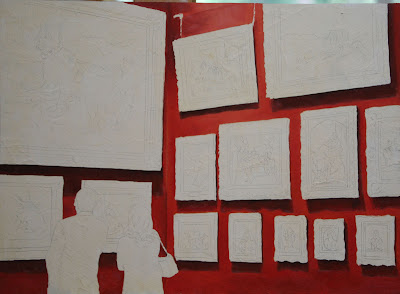
Second, painting the gold frames. One of the unique aspects of this painting is how creative I have to be to pull it off, yet not alter reality. Each of these famous paintings has a particular frame. I couldn't just put on a frame that was easier to paint. I designated a separate palette for just different shades of yellow, yellow ochre and browns. There are also some reds, oranges and blues in the frames for reflections and ornate corners.
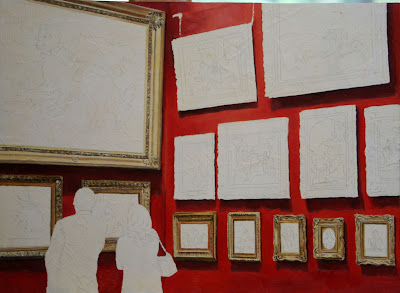
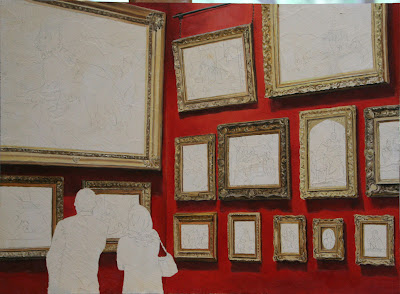
Often I use my summer paintings to tackle new ideas and inspiration. In this painting, I'm climbing Everest! It is so challenging that it is difficult to see the summit.
So strap on your crampons and grab your parka. Up we go.
It was the Victoria & Albert Museum in London which inspired this painting. I was admiring the huge array of masters when I walked into a red room. Not only did the color of the wall thrill me, but the paintings were ones I could stare at all day. I knew I had to paint this room.
It is one thing to paint interiors, but a room full of master paintings? 14 of them? Was I crazy?
I decided to tackle this in stages.
Base camp.
First, paint the wall. It is just a red wall, right? Wrong. It is red, rose, orangey, maroon. I couldn't believe how one color can be so many.

Second, painting the gold frames. One of the unique aspects of this painting is how creative I have to be to pull it off, yet not alter reality. Each of these famous paintings has a particular frame. I couldn't just put on a frame that was easier to paint. I designated a separate palette for just different shades of yellow, yellow ochre and browns. There are also some reds, oranges and blues in the frames for reflections and ornate corners.


Friday, July 15, 2011
Finished
14.5" X 20"
Original Oil
It has taken me a while to post the finished painting. Thank you for your patience. I wanted to wait until it was dry and I could get a good scan of it.
After the last blog post, the first thing I painted was faces. Well, sort of faces. All you can see of these guards is their nose and mouth. It was interesting creating different facial expressions without using the men's eyes.
Also, I have "blued-up" the horses. Note my very technical painting term. The horses seemed a little brownish so I applied a glaze with some blues and purples to enhance the feeling of jet black.
The title, In Her Service, came to me near the beginning of the painting. Of course I am referring to Her Majesty Queen Elizabeth II.
My trip to London was very inspirational. So, not wanting to leave England just yet in my painting journey, I will next start posting an absolutely crazy painting challenge. I saw it and knew I had to paint it! Stay tuned.
Original Oil
It has taken me a while to post the finished painting. Thank you for your patience. I wanted to wait until it was dry and I could get a good scan of it.
After the last blog post, the first thing I painted was faces. Well, sort of faces. All you can see of these guards is their nose and mouth. It was interesting creating different facial expressions without using the men's eyes.
Also, I have "blued-up" the horses. Note my very technical painting term. The horses seemed a little brownish so I applied a glaze with some blues and purples to enhance the feeling of jet black.
The title, In Her Service, came to me near the beginning of the painting. Of course I am referring to Her Majesty Queen Elizabeth II.
My trip to London was very inspirational. So, not wanting to leave England just yet in my painting journey, I will next start posting an absolutely crazy painting challenge. I saw it and knew I had to paint it! Stay tuned.
Monday, July 4, 2011
The British are coming, The British are coming!
Happy 4th of July!
It might seem odd to you that today I post my continuing piece of the Horse Guards which keep watch over Buckingham Palace.
It might seem odd to you that today I post my continuing piece of the Horse Guards which keep watch over Buckingham Palace.
But since I am posting the red of their uniform, it is fitting.
Growing up, my Dad thought we should experience history on the 4th of July by reinacting the Revolutionary War. This required some artistic license as we had an entire cast of .... five. Mom, Dad, my younger brother, my younger sister, and me. Dad would grab the World Almanac and we would begin with heroic accuracy. Unfortunately, all three kids wanted to be the British. You see the British got to find something red to wear and then we got to DIE! The death scenes were particularly dramatic as you would expect. I remember one time Dad said, "OK, Somebody has to be a Colonist!"
We had Paul Revere running around the living room (I usually got that part), and once I took French in high school, I was the entire French army because I could sing the French national anthem.
In the end, we all had a chance to die and then celebrate the victory of the American colonists. Along with much silliness, there was warm deep laughter. Dad would vow at the end that next year, we would have more history in our reinactment. Of course next year came and once again our performance would de-evolve into fits of laughter.
This year I plan to start a reinactment with 2 of my nieces and a nephew. I have the perfect sweatshirt from my trip to London and I am already "strategizing" my death scene.
Here is my latest on the Horse Guard painting with their red. The color of the building was a little too warm so I have added blue to the left and middle sections and will add a bit to the right side.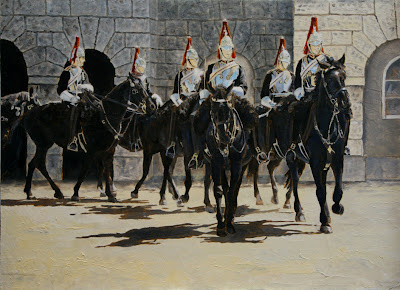
Growing up, my Dad thought we should experience history on the 4th of July by reinacting the Revolutionary War. This required some artistic license as we had an entire cast of .... five. Mom, Dad, my younger brother, my younger sister, and me. Dad would grab the World Almanac and we would begin with heroic accuracy. Unfortunately, all three kids wanted to be the British. You see the British got to find something red to wear and then we got to DIE! The death scenes were particularly dramatic as you would expect. I remember one time Dad said, "OK, Somebody has to be a Colonist!"
We had Paul Revere running around the living room (I usually got that part), and once I took French in high school, I was the entire French army because I could sing the French national anthem.
In the end, we all had a chance to die and then celebrate the victory of the American colonists. Along with much silliness, there was warm deep laughter. Dad would vow at the end that next year, we would have more history in our reinactment. Of course next year came and once again our performance would de-evolve into fits of laughter.
This year I plan to start a reinactment with 2 of my nieces and a nephew. I have the perfect sweatshirt from my trip to London and I am already "strategizing" my death scene.
Here is my latest on the Horse Guard painting with their red. The color of the building was a little too warm so I have added blue to the left and middle sections and will add a bit to the right side.

Saturday, July 2, 2011
The Guards
I thought the background looked too light, so I darkened it a bit.
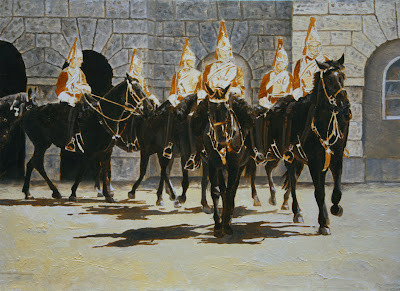
With the horses completed, except for the tack, it is time to start on the Horse Guards.
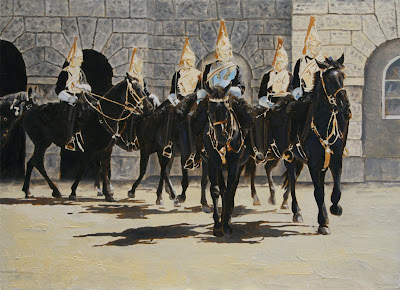
I start with the black shirts, then the cuffs. Next is the really fun part - the breast plates. The sky is reflected in them which adds a wonderful blue to the painting. At least one breast plate will mirror the monument at the end of the parade grounds.

With the horses completed, except for the tack, it is time to start on the Horse Guards.

I start with the black shirts, then the cuffs. Next is the really fun part - the breast plates. The sky is reflected in them which adds a wonderful blue to the painting. At least one breast plate will mirror the monument at the end of the parade grounds.
Subscribe to:
Posts (Atom)



